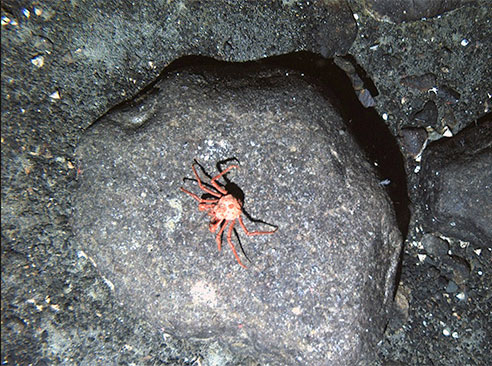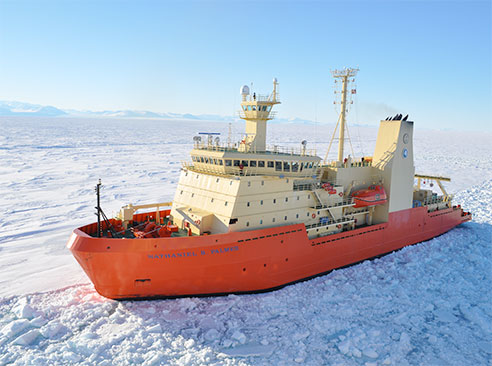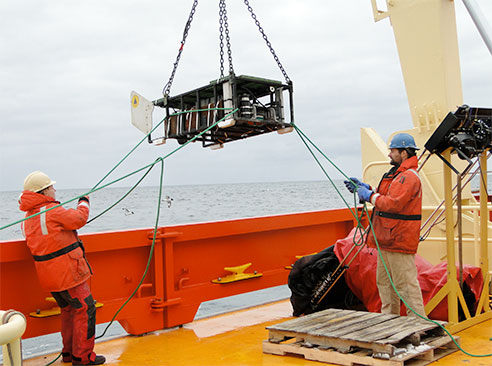Need more information? Contact us
 The king crab Paralomis birsteini, photographed on the continental slope off Marguerite Bay, Antarctica, at a depth of 1100 m.King crabs may soon become high-level predators in Antarctic marine ecosystems where they have not played a role in tens of millions of years, according to a new study on which University of Alabama at Birmingham researchers worked in conjunction with the Florida Institute of Technology and other institutions.
The king crab Paralomis birsteini, photographed on the continental slope off Marguerite Bay, Antarctica, at a depth of 1100 m.King crabs may soon become high-level predators in Antarctic marine ecosystems where they have not played a role in tens of millions of years, according to a new study on which University of Alabama at Birmingham researchers worked in conjunction with the Florida Institute of Technology and other institutions.
“No Barrier to Emergence of Bathyal King Crabs on the Antarctic Shelf,” published this week in the Proceedings of the National Academy of Sciences, ties the reappearance of these crabs to global warming.
This study is a continuation of previous work in the field of Antarctic marine ecology done by James McClintock, Ph.D., paper co-author and professor in UAB’s College of Arts and Sciences’ Department of Biology, along with his colleagues.
“The rising temperature of the ocean west of the Antarctic Peninsula — one of the most rapidly warming places on the planet — should make it possible for king crab populations to move to the shallow continental shelf from their current deep-sea habitat within the next several decades,” said lead author Richard Aronson, Ph.D., professor and head of Florida Tech’s Department of Biological Sciences.
Researchers found no barriers, such as salinity levels, types of sediments on the seafloor or food resources, to prevent the predatory crustaceans from arriving if the water became warm enough. That arrival would have a huge impact.
“Because other creatures on the continental shelf have evolved without shell-crushing predators, if the crabs moved in they could radically restructure the ecosystem,” Aronson said.
 Nathaniel B. Palmer in the ice off Marguerite Bay.The study provides initial data and does not by itself prove that crab populations will expand into shallower waters.
Nathaniel B. Palmer in the ice off Marguerite Bay.The study provides initial data and does not by itself prove that crab populations will expand into shallower waters.
“The only way to test the hypothesis that the crabs are expanding their depth-range is to track their movements through long-term monitoring,” McClintock said.
In the 2010 to 2011 Antarctic summer, in research funded by the National Science Foundation, the team used an underwater camera sled to document a reproductive population of the crabs for the first time on the continental slope off Marguerite Bay on the western Antarctic Peninsula. That area is only a few hundred meters deeper than the continental shelf where the delicate ecosystem flourishes.
“The mounting anticipation as the researchers watched the transmissions from the seafloor culminated in a mixture of both satisfaction and unease upon the seeing the first image of a king crab on the Antarctic slope,” said Margaret Amsler, a research assistant and co-author from UAB.
“The overall effect of the migration of king crabs to shallower waters,” said postdoctoral scientist and study co-author Kathryn Smith of Florida Institute of Technology, “would be to make the unique Antarctic ecosystem much more like ecosystems in other areas of the globe, a process ecologists call biotic homogenization.”
 SeaSled towed vehicle being deployed from the Palmer off Marguerite Bay.Such changes, the researchers concluded, would fundamentally alter the Antarctic seafloor ecosystem and diminish the diversity of marine ecosystems globally.
SeaSled towed vehicle being deployed from the Palmer off Marguerite Bay.Such changes, the researchers concluded, would fundamentally alter the Antarctic seafloor ecosystem and diminish the diversity of marine ecosystems globally.
The data used in the paper were collected during an expedition to Antarctica run jointly by NSF, the Swedish Polar Research Secretariat and the Swedish Research Council. The expedition included scientists from Florida Tech, UAB, the Woods Hole Oceanographic Institution, the University of Gothenburg in Sweden and the University of Southampton in the United Kingdom.
Journalists may access the embargoed paper through EurekAlert. They should register with www.eurekalert.org/register.php and request access to PNAS materials. Already registered journalists may request access to PNAS at www.eurekalert.org/account.php.
A video version of this news story available by contacting Dena Headlee at dheadlee@nsf.gov or (703) 292-7739.